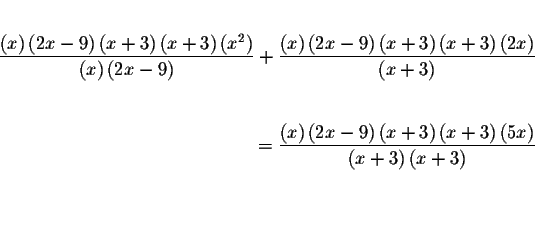 EQUATIONS INVOLVING
FRACTIONS (RATIONAL EQUATIONS)
EQUATIONS INVOLVING
FRACTIONS (RATIONAL EQUATIONS)
 EQUATIONS INVOLVING
FRACTIONS (RATIONAL EQUATIONS)
EQUATIONS INVOLVING
FRACTIONS (RATIONAL EQUATIONS)

Note:
If you would like an in-depth review of fractions, click on Fractions.
Solve for x in the following equation.
Example 3:

Rewrite the equation such that all the denominators are factored:

Recall that you cannot divide by zero. Therefore, the first fraction is
valid if ,
 the second fraction is valid
if
the second fraction is valid
if
![]() and the third fraction is valid is
and the third fraction is valid is ![]() . If 0,-3, or
. If 0,-3, or
![]() turn out to be the solutions, you
must discard them as extraneous solutions.
turn out to be the solutions, you
must discard them as extraneous solutions.
Multiply both sides of the equation by an expression that represents the
lowest common denominator. The expression
![]() is the smallest expression
because it is the smallest expression that is divisible by all three
denominators.
is the smallest expression
because it is the smallest expression that is divisible by all three
denominators.



This equation can be written as

Multiply the fractions where indicated.

Rearrange the factors in the numerators and rewrite the equations as

Rewrite the equation once again as



Simplify the last equation and solve for x.

![\begin{eqnarray*}&& \\
\left[ \left( x+3\right) \left( x+3\right) \left( x^{2}\...
... 5x\right) \left( x\right) \left(
2x-9\right) \right] \\
&& \\
\end{eqnarray*}](img20.gif)
![\begin{eqnarray*}&& \\
\left[ \left( x^{2}+6x+9\right) \left( x^{2}\right) \rig...
...x^{3}-54x^{2}\right]
&=&\left[ 10x^{3}-45x^{2}\right] \\
&& \\
\end{eqnarray*}](img21.gif)


Since ![]() ,
the only solution is x=2.
,
the only solution is x=2.
The original equation has one real solution at x=2.:
Check the answer in the original equation.
Check the solution x=2 by substituting 2 in the original equation for x.
If the left side of the equation equals the right side of the equation after
the substitution, you have found the correct answer.

 .
.
Since the left side of the original equation is not equal to the right side of the original equation after we substitute the value 2 for x, then x=2is a solution.
You can also check your answer by graphing

This means that there is one real solution and the solution is x=2.
If you would like to test yourself by working some problems similar to this example, click on Problem
If you would like to go back to the equation table of contents, click on
Contents

